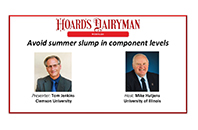 "You cannot make a Holstein a Jersey," teased Tom Jenkins during the Hoard's Dairyman monthly webinar. Genetics plays a big role in components. We can fine-tune our rations to take advantage of a few scenarios, but there's no management silver bullet to dramatically bolster components during the hotter months of the year.
"You cannot make a Holstein a Jersey," teased Tom Jenkins during the Hoard's Dairyman monthly webinar. Genetics plays a big role in components. We can fine-tune our rations to take advantage of a few scenarios, but there's no management silver bullet to dramatically bolster components during the hotter months of the year.We're all familiar with summer's depressed fat and protein levels. June, July and August are the lowest and the gradual climb puts January and February at the peak. It is cyclical and predictable, year after year. The dip can be a 0.02 to 0.04 variance, which can be significant in a component-based milk market.
Summer brings heat stress, high temperatures and humidity. And low components occur at about the same time, so they're correlated, right? Not necessarily. The Clemson University professor emeritus presented data from different regions of the country with varying temperature and humidity levels. All still experienced the summer slump.
He then turned toward feed changes. Over the course of the year, ration compositions do change. But his review of feed analyses changes still did not explain the seasonal variations in milk components. So, feed quality itself cannot be the culprit.
The often-blamed, third possible cause is hormonal changes due to photoperiod. The changing day length and additional sun exposure has some people thinking those changes lead to milk synthesis changes. While greater daylight exposure can boost milk yield by 5 to 6 pounds, day length had no impact on component levels.
Since many of the long accepted theories have been dispelled, is there really anything that we can do to avoid the dip?
Jenkins spent much of the presentation discussing conjugated linoleic acids (CLA) and how some of them are milkfat inhibitors. Some CLAs contain milkfat depressants so when present, they impact the cow's ability to make milk with normal component levels.
Some of his guidelines:
- Absolute maximum total fat in a ration: 7 percent (dry matter basis)
- Only 3 percent fat from oilseed, distillers grains and liquid fats
- Avoid excessive unsaturated fats
- Feed up to 2 percent bypass fat
Learn more about avoiding the summer slump, watch the archived webinar. Past webinars can be found at www.hoards.com/webinars.
Webinars, or Dairy Management follow these links.

The author is the online media manager and is responsible for the website, webinars and social media. A graduate of Modesto Junior College and Fresno State, she was raised on a California dairy and frequently blogs on youth programs and consumer issues.








